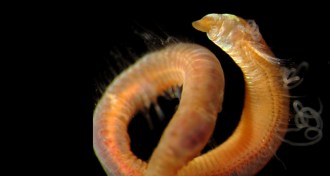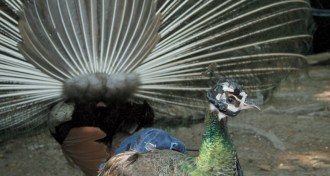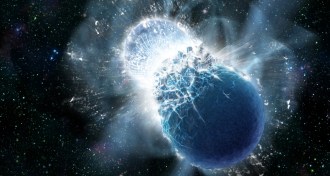News
-
 Physics
PhysicsDoppler effect takes a spin
Light’s twistiness allows researchers to measure rotating object’s speed.
By Andrew Grant -
 Humans
HumansY chromosome analysis moves Adam closer to Eve
A pair of genetic studies has pushed back age of men's most recent common ancestor.
By Erin Wayman -
 Neuroscience
NeuroscienceCamping resets internal clock
After a week in the wild, people went to bed and got up earlier.
By Meghan Rosen -
 Health & Medicine
Health & MedicineGoing out to lunch zaps mental focus
Sharing a midday meal with friends could lead later to errors at work.
-
 Animals
AnimalsOxygen boost aided carnivore evolution in Cambrian explosion
Atmospheric change and rise of predators caused burst in complexity of life.
By Erin Wayman -
 Health & Medicine
Health & MedicineFull moon may mean less sleep
Slumber waxes and wanes along with lunar rhythm, researchers find with people sleeping in windowless lab.
-
 Health & Medicine
Health & MedicineGastric bypass surgery causes sugar-burning gut growth in rats
The rapid improvement in symptoms of diabetes, seen in patients before weight loss begins, may be due to changes in part of the intestine.
By Meghan Rosen -
 Life
LifeA flash of light implants false memories in mice
Researchers alter rodents' recollections by exciting just a few neurons.
-
 Animals
AnimalsEye-tracking cameras show peahens’ wandering gaze
Data show that female birds are not so riveted by their suitors’ magnificence
By Susan Milius -
 Life
LifeRogue genes on X chromosome turn on in testicles
Chunks of rapidly evolving DNA could affect sperm production in males.
-
 Cosmology
CosmologyGold seen in neutron star collision debris
Material ejected in gamma-ray bursts may be a main source of the heavy elements.
By Erin Wayman -
 Life
LifeGut microbes get first dibs on heart meds
Some people harbor a strain of bacteria that chews through cardiac medication before it can treat symptoms.